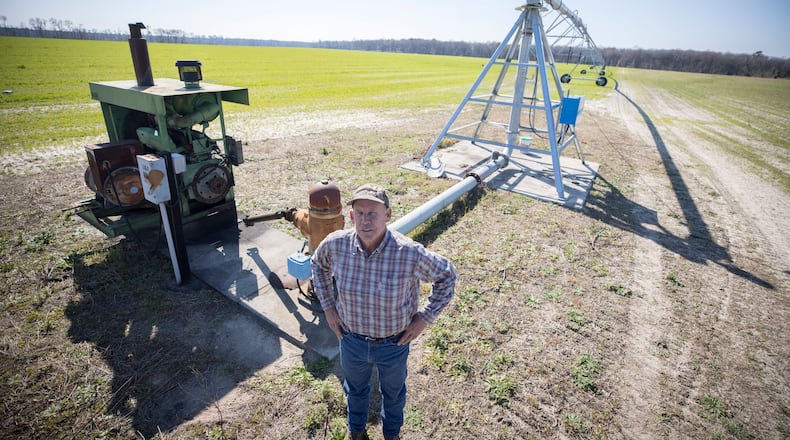SOUTH BULLOCH COUNTY, Ga. — On nearly 3,000 acres 20 miles west of Savannah, Hyundai Motor Group is racing to finish its “Metaplant” electric vehicle factory by early 2025, if not sooner.
The plant — Georgia’s largest economic development project, which Hyundai has promised will employ 8,500 — has already begun to transform a rural stretch of I-16 between Statesboro and Savannah into an industrial corridor lined with parts suppliers and warehouses. But the hulking factory will require enormous amounts of water, and state and local leaders’ plan to quench its thirst by pumping from the underlying aquifer has sparked fear in surrounding counties.
Credit: Stephen B. Morton for The Atlanta Journal Constitution
Credit: Stephen B. Morton for The Atlanta Journal Constitution
The Metaplant’s water supply, at least for now, will not come from Bryan County, where the factory is located. Nor will it come from Savannah. Instead, to get around pumping restrictions that have been in place to limit saltwater intrusion in the aquifer, groundwater will be pumped from four wells drilled just north of the plant in Bulloch County.
Farmers like Ray Davis, who grows cotton and peanuts on land about 2 miles from some of the proposed well sites, worry the plans could compromise their water supply or lead to crop failures.
The four wells could be allowed to suck a combined 6.65 million gallons a day from the Floridan Aquifer — the massive, underground reservoir beneath South Georgia, Florida and parts of surrounding states. Even more water might be pulled later to support new development and a Bulloch-owned water and sewer system in the southern part of the county.
Credit: Stephen B. Morton for The Atlanta Journal Constitution
Credit: Stephen B. Morton for The Atlanta Journal Constitution
Davis, a sixth-generation farmer, relies on the same aquifer to irrigate his fields. If the water table drops, Davis says a local well driller estimated it could cost him $30,000 apiece to lower the pumps in two of his wells. If larger engines are needed, his tab could rise to around $100,000 per well, not to mention the increased fuel and electricity to pull water from farther below ground.
“These wells are gonna cost me money, even if they don’t hurt my crops or my cost of production,” he said.
No permits have been issued yet by the Georgia Environmental Protection Division (EPD), and the agency, county officials and the regional economic development authority have floated safeguards to protect affected farmers and homeowners.
Credit: Stephen B. Morton for The Atlanta Journal Constitution
Credit: Stephen B. Morton for The Atlanta Journal Constitution
Still, the issue has spawned significant local opposition.
David Bennett, an Army veteran and flight nurse, is challenging the incumbent Bulloch Commission Chairman Roy Thompson in May’s Republican primary. Bennett also fears for his home’s water supply. He’s called for a drilling moratorium and a referendum to give voters a say.
“I feel like we’re putting money and growth ahead of the people that are here right now,” Bennett said.
Saltwater intrusion
Why Bulloch will supply Hyundai’s water, at least for now, can be traced to a decade-old deal between Georgia and South Carolina.
Water tests in the early 2000s from aquifer wells in Hilton Head Island, S.C., northeast of Savannah, found saltwater concentrations were rising in the island’s water supply. An investigation determined Savannah-area wells were over-pumping and increasing the rate of saltwater intrusion in the aquifer. In 2013, the EPD imposed caps for Chatham and Bryan counties and part of neighboring Effingham County.
Officials feared all of Hilton Head’s wells could be contaminated by 2025 without the curbs.
Credit: Stephen B. Morton for The Atlanta Journal Constitution
Credit: Stephen B. Morton for The Atlanta Journal Constitution
Georgia officials accepted the limits to avoid a legal fight and because the federal, state and local governments were investing in a freshwater reservoir built as part of the Savannah River harbor deepening project. The 97 million gallon reservoir was completed in 2018.
The reservoir is seen as the means to meet Savannah’s water needs in the future — and possibly Hyundai’s too.
But its water distribution network is still under construction and the Metaplant is scheduled to begin production early next year. Hyundai’s needs in Bryan County, coupled with increased water demand in Bulloch tied to Hyundai-related residential and commercial development, led to the counties collaborating on the four wells.
Credit: Stephen B. Morton for The Atlanta Journal Constitution
Credit: Stephen B. Morton for The Atlanta Journal Constitution
Hyundai declined comment and referred a reporter to the Savannah Economic Development Authority (SEDA).
SEDA CEO Trip Tollison called the Bulloch plan “a great win-win for those counties and a great win for Savannah because it buys time for them to get the surface water plan stood up.”
Still, residents like Davis and Bennett fear saltwater intrusion will worsen in the aquifer.
James Reichard, a professor of hydrology at Georgia Southern University, said that’s unlikely, especially as far inland as southern Bulloch. But it’s possible the pumping could lower the wells of those living within a few miles, Reichard said.
Credit: Stephen B. Morton for The Atlanta Journal Constitution
Credit: Stephen B. Morton for The Atlanta Journal Constitution
Sinkholes are another potential threat.
Reichard said three have been identified elsewhere in Bulloch in recent years, though many more likely exist. Predicting where they will form though, he said, is difficult.
“There are a lot of these that are buried geologically that have probably been there for thousands of years, but you don’t know they are there until you pump,” he said.
Shifting to surface water
EPD and other officials are expected to address concerns at a local public meeting on Monday.
EPD declined to comment on the proposed wells, but a notice for the meeting says the agency will provide the results of hydrologic modeling and show the projected impacts at specific sites.
EPD and the Savannah Joint Development Authority (JDA) — which includes SEDA and economic development agencies from Bryan, Effingham and Bulloch counties — have also floated special permit conditions to protect farmers and residents whose wells are affected.
Credit: Stephen B. Morton for The Atlanta Journal Constitution
Credit: Stephen B. Morton for The Atlanta Journal Constitution
Draft provisions viewed by The Atlanta Journal-Constitution include the creation of a joint Bulloch-Bryan County fund to help farmers and others pay for upgrades, like lowering well pumps.
Tom Couch, the county manager for Bulloch County, said the details are still being negotiated and could include both public and private dollars.
“What we’re trying to do is use resources that don’t hit the taxpayer pockets of either Bulloch or Bryan Countians,” Couch said.
The proposal also calls for limiting pumping to 25 years, and for Bulloch and Bryan counties to develop a surface water alternative, such as a reservoir, as fast as possible to protect the aquifer.
Credit: Stephen B. Morton for The Atlanta Journal Constitution
Credit: Stephen B. Morton for The Atlanta Journal Constitution
Damon Mullis, the executive director of the Ogeechee Riverkeeper, said reducing reliance on groundwater is critical to the region’s long-term sustainability.
“Surface water just isn’t as clean as water from the Floridan Aquifer,” Mullis said. “And as we grow ... groundwater should be reserved for drinking water and food production, and industry should rely on the surface water.”
Keep Reading
The Latest
Featured














